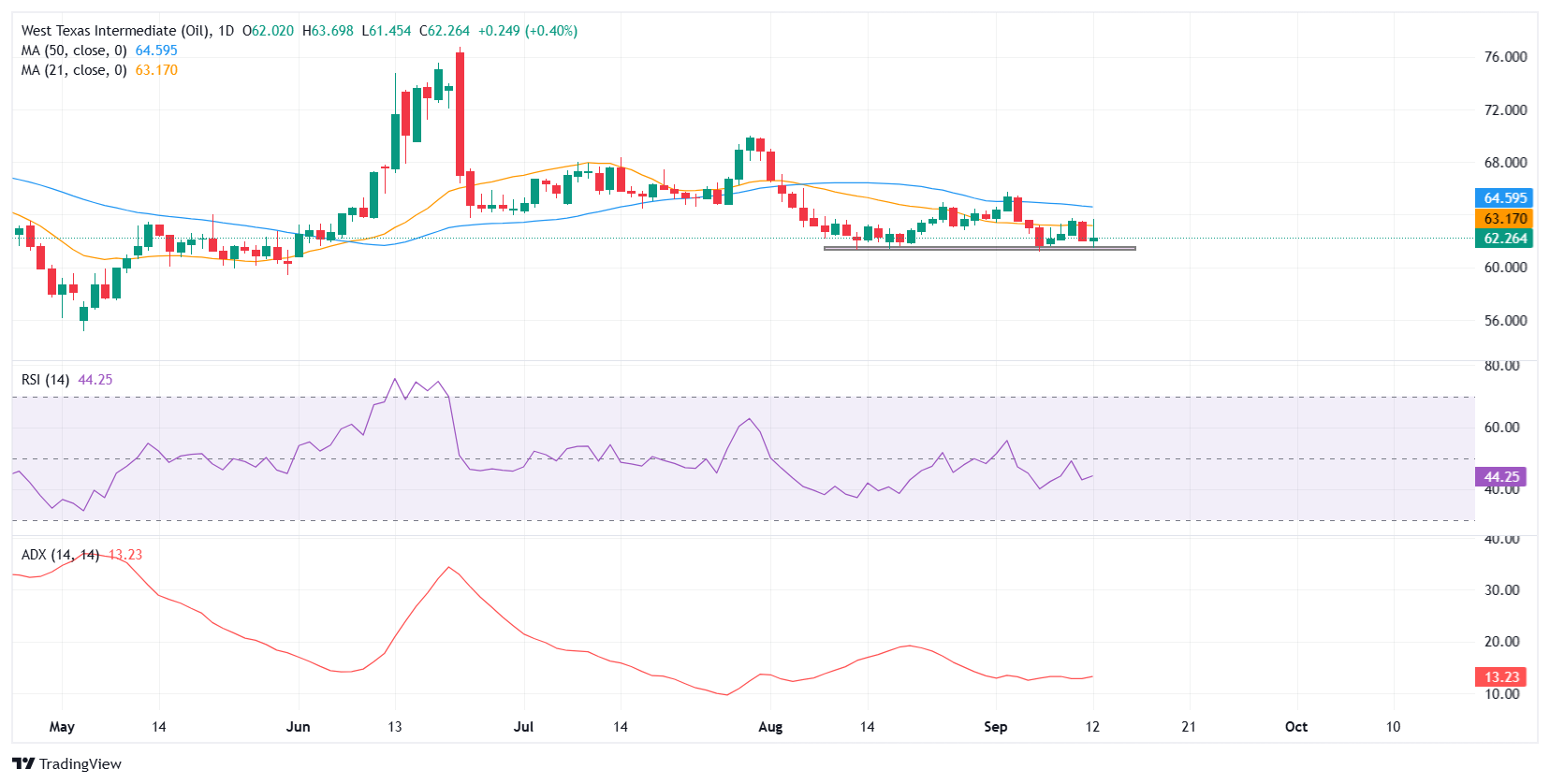WTI Price Forecast: Momentum fades below 21-day SMA
- WTI trims intraday gains after facing resistance at the 21-day SMA.
- Technical resistance remains firm, with price action capped near $63.50 and momentum indicators signaling subdued trend strength.
- Immediate support rests at $61.50; a break lower could expose $60.50–59.50.
West Texas Intermediate (WTI) Crude Oil reversed course during the American session on Friday, paring intraday gains after hitting a daily high of $63.69. The US benchmark faced renewed selling pressure as bears defended the 21-day Simple Moving Average (SMA), a level that has repeatedly capped upside momentum in recent days.
At the time of writing, WTI is changing hands near $62.30, still up nearly 0.50% on the day. The failure to break above the 21-day SMA reflects cautious sentiment as demand signals weaken. In the US, the latest weekly data showed gasoline demand slipping while inventories held stubbornly high, underscoring softer consumption trends.
At the same time, inflation readings remain sticky, raising concerns that higher fuel costs could further restrain household spending. On the supply side, the International Energy Agency (IEA) warned that global Oil markets could shift into surplus in the second half of 2025, driven by OPEC+ production returning to the market. This combination of fragile demand and rising supply is keeping traders reluctant to place aggressive bets.
On the geopolitical front, traders continue to monitor Russian supply risks following reports of infrastructure vulnerabilities, while speculation about renewed sanctions on energy exports lingers in the background. The European Commission is preparing to present its 19th package of sanctions against Russia next Wednesday. In parallel, the United States has stepped up calls on G7 and EU partners to impose tariffs on China and India over their continued purchases of discounted Russian crude.

From a technical standpoint, WTI faces stiff resistance at $63.50 resistance zone, anchored by the 21-day SMA. A decisive break higher would open the way toward $64.50 and the psychological $65.00 level. On the downside, the first line of defense sits at $61.50. A decisive daily close beneath this level could open the door for a deeper pullback toward $60.50 and potentially $59.50 in the near term.
Momentum indicators remain subdued, with the Relative Strength Index (RSI) hovering just below 50 and the Average Directional Index (ADX) showing weak trend strength, suggesting further range-bound trading in the near term.
WTI Oil FAQs
WTI Oil is a type of Crude Oil sold on international markets. The WTI stands for West Texas Intermediate, one of three major types including Brent and Dubai Crude. WTI is also referred to as “light” and “sweet” because of its relatively low gravity and sulfur content respectively. It is considered a high quality Oil that is easily refined. It is sourced in the United States and distributed via the Cushing hub, which is considered “The Pipeline Crossroads of the World”. It is a benchmark for the Oil market and WTI price is frequently quoted in the media.
Like all assets, supply and demand are the key drivers of WTI Oil price. As such, global growth can be a driver of increased demand and vice versa for weak global growth. Political instability, wars, and sanctions can disrupt supply and impact prices. The decisions of OPEC, a group of major Oil-producing countries, is another key driver of price. The value of the US Dollar influences the price of WTI Crude Oil, since Oil is predominantly traded in US Dollars, thus a weaker US Dollar can make Oil more affordable and vice versa.
The weekly Oil inventory reports published by the American Petroleum Institute (API) and the Energy Information Agency (EIA) impact the price of WTI Oil. Changes in inventories reflect fluctuating supply and demand. If the data shows a drop in inventories it can indicate increased demand, pushing up Oil price. Higher inventories can reflect increased supply, pushing down prices. API’s report is published every Tuesday and EIA’s the day after. Their results are usually similar, falling within 1% of each other 75% of the time. The EIA data is considered more reliable, since it is a government agency.
OPEC (Organization of the Petroleum Exporting Countries) is a group of 12 Oil-producing nations who collectively decide production quotas for member countries at twice-yearly meetings. Their decisions often impact WTI Oil prices. When OPEC decides to lower quotas, it can tighten supply, pushing up Oil prices. When OPEC increases production, it has the opposite effect. OPEC+ refers to an expanded group that includes ten extra non-OPEC members, the most notable of which is Russia.


